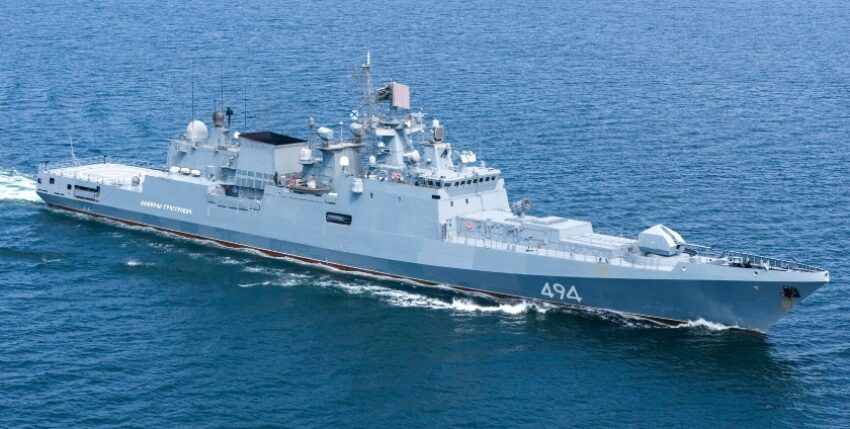In the summer of 2025, the Russian Navy deployed surface units and a conventional submarine between the Baltic Sea, the North Atlantic and the Mediterranean. The deployments were visibly and operationally closely interlinked. What can be seen as a reaction to NATO activities is also an expression of strategic adaptation and political signalling at sea.
Frigate rotation: "Admiral Grigorovich" in the Baltic Sea
The frigate "Admiral Grigorovich" (type ship, 125 metres, 4,000 tonnes) returned to the Baltic Sea at the end of June after almost two years in the Mediterranean via the North Sea and Skagerrak. She is now stationed in Kronstadt/Saint Petersburg and reinforces the Baltic Fleet. On the one hand, the continued closure of the Bosporus prevents her from returning to her home fleet in the Black Sea, but on the other hand, the availability of a modern platform near the major city makes perfect sense, as her deployment against a presumably Ukrainian drone attack on the Kronstadt naval base on 27 July shows: The Baltic Sea is no longer a rearward theatre of operations for Russia.
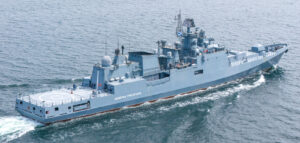
Landing ship "Alexander Shabalin" in the Skagerrak
Between June and July, the landing ship "Alexander Shabalin" (Ropucha class, 112 metres, 4,400 tonnes) operated in the Skagerrak. The ship was equipped with a conspicuous number of searchlights, presumably for drone defence. The presence between the Baltic and North Seas and in the narrow sea lanes between NATO neighbours, combined with simulated combat exercises against mines and unmanned systems, underlines the adaptation of Russian naval operations to asymmetric threats.
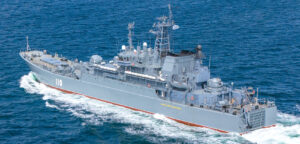
Destroyer for Kaliningrad: "Vice Admiral Kulakov" accompanies Baltic Sea exercises
The Northern Fleet unit "Vizeadmiral Kulakov" (Udaloy I-class, 164 metres, 7,600 tonnes) operated in the Baltic Sea for several weeks - initially flanked by the frigate "Admiral Kasatonov" (see below). The destroyer took part in submarine hunting manoeuvres and showed an unusually active presence between Baltiysk, Gotland and the Gulf of Finland. The aggressive tracking of the German frigate "Bayern" during its journey to US BALTOPS caused a stir. Suspicions regarding a longer-term stationing of the "Vizeadmiral Kulakov" as the (interim) flagship of the Baltic Fleet do not appear unfounded, as the current Sovremenny-class destroyer "Nastoychivy" (156 metres, 8,000 tonnes) has not been seen underway for some time.

Transit to the Mediterranean: "Novorossiysk" with escorts
On 21 June, the Kilo II-class submarine "Novorossiysk" (74 metres, 3,000 tonnes) left the Baltic Sea with the support of the ocean-going tug "Yakov Grebelsky", accompanied by the frigate "Admiral Kasatonov" as far as the Great Belt. However, the disparate convoy confirms Russia's ability to deploy conventional submarines over long distances - despite logistical gaps in the Mediterranean, where the loss of the Tartus base in Syria is clearly making itself felt. At the end of July, the "Novorossiysk" then operated west of Alexandria - Egypt apparently served as a logistical stopover. However, without a fixed base in Syria, range and technical endurance can only be ensured by escort vehicles such as the "Yakov Grebelsky". The deployment in the immediate vicinity of NATO bases on Crete and Cyprus emphasises Moscow's claim to also have a maritime presence and military impact in the Mediterranean - and that its range has remained intact. The conspicuous visibility of the transit through the North Sea, English Channel and Atlantic was probably also politically intentional: "We can still do it!"
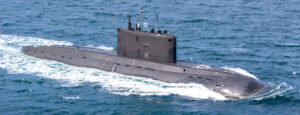
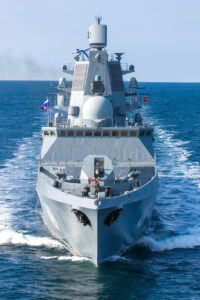
"Admiral Kasatonov" back to the Northern Fleet after Baltic Sea interlude
The Russian Navy's most modern multi-purpose frigate (Admiral Gorshkov class, 135 metres, 5,400 tonnes, since 2020) was only in the Baltic Sea for a few weeks and also left the sea area on 21 June. Her visit coincided with the large-scale NATO exercise US-BALTOPS and was obviously for the purposes of presence and information gathering. The redeployment before 27 July - the "Admiral Kasatonov" was originally intended for the naval parade to mark the navy's birthday - points to a new risk assessment: the Baltic Sea is increasingly seen by Moscow as a threatened area in which high-value targets do not stay unnecessarily long if they can be more useful elsewhere.
The transfer of the "Admiral Kasatonov" to the Baltic Sea - at the same time as the destroyer "Vizeadmiral Kulakov" - probably served primarily to support the Baltic Fleet during exercises and demonstrative appearances. The ship, which belonged to the Northern Fleet, was then freed up again for strategic tasks in the North Sea, where it is of particular importance as a carrier of the Zirkon hypersonic missiles. Officially, the Zirkon can reach targets over 1,000 km away at many times the speed of sound and overcome modern air defences thanks to its manoeuvrability - a message that is often repeated to NATO countries. With the return of the "Admiral Kasatonov", this capability is once again available in the primary area of responsibility of the Northern Fleet, where the bulk of the Russian fleet is stationed, where Russia's most sensitive naval installations ('the Bastion') are located, and where the strategic North-East Passage begins.
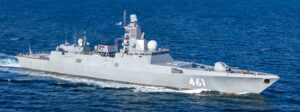
Conclusion: Visible presence despite structural limits
The observed movements of the Russian units have tied up considerable resources and required careful planning. Moscow is thus underlining its claim to be a global navy operating beyond the Baltic and Mediterranean - as the current Sino-Russian manoeuvres in the Western Pacific also demonstrate. By deploying frigates, landing ships and submarines, Russia is emphasising its ability to act, responding to new threats (drones) and countering NATO's increased presence at sea.
H. U. Mergener, Michael Nitz, ajs

